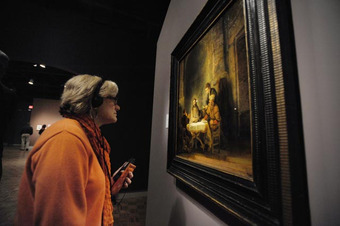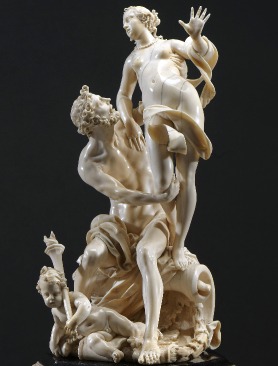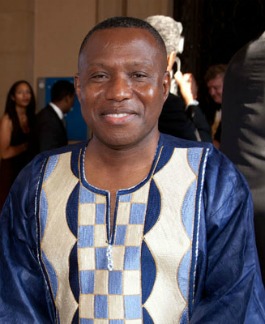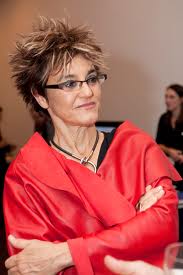Alexander McQueen isn’t the only guy capable of drawing crowds so big that hours must be extended at a museum. Or Leonardo, for that matter.
I’m happy to report that the Detroit Institute of Art recently added hours to accommodate visitors to its Rembrandt and the Face of Jesus exhibition.
 On Jan. 4, the DIA announced that the Rembrandt exhibit “broke attendance records for recent exhibitions at the museum, with more than 15,000 visitors during the week between Christmas and New Year’s. The number is around three times the typical weekly attendance for the exhibition.”
On Jan. 4, the DIA announced that the Rembrandt exhibit “broke attendance records for recent exhibitions at the museum, with more than 15,000 visitors during the week between Christmas and New Year’s. The number is around three times the typical weekly attendance for the exhibition.”
At the time, museum hours were 10 a.m. to 4 p.m. on Wednesdays and Thursdays, 10 a.m.-10 p.m. Fridays, and 10 a.m.-5 p.m. Saturdays and Sundays.
Then, on Jan. 13, the DIA would stay open longer for that exhibition and the whole museum until Feb. 12, when the Rembrandt show must come down. For the month of January, then, the DIA will say open on Saturdays and Sundays from 10 a.m. to 8 p.m. Also, on the first two Saturdays in February, hours are 10 a.m. to 10 p.m., and on the first two Sundays of February, hours are 10 a.m. to 8 p.m.
The DIA hasn’t done this “in several years,” says the announcement, which noted that it has extended hours “in the final week for past blockbuster exhibitions, such as Van Gogh: Face to Face and Degas and the Dance.”Â
In the first press release, DIA director Graham Beal says, “The response has been overwhelming. Much of the positive feedback we have received focuses on how the exhibition is presented, which places Rembrandt and the works of art in historical and cultural context. We are delighted that our presentation has resonated with so many visitors.”
I’m thrilled — we all know Detroit (the city) is a bit of a mess. Good news is welcome, to put it mildly. This exhibition was organized by the DIA with the Louvre and the Philadelphia Museum of Art, where it was shown last August through October.
If you go to the exhibition notice on the DIA website, you’ll find links to videos about the show and a slide show of Rembrandt’s home in Antwerp. A little value added.
Photo Credit: Courtesy of the Detroit News (Brandy Baker)

 Much of the general public probably thinks that’s a ripoff, which is one reason I wanted to write about this piece. I leave it you to decide if it’s worth that high amount, but the story of how it gained value, going from a piece attributed to Matthias Steinl to one definitely by him, is a good tale.
Much of the general public probably thinks that’s a ripoff, which is one reason I wanted to write about this piece. I leave it you to decide if it’s worth that high amount, but the story of how it gained value, going from a piece attributed to Matthias Steinl to one definitely by him, is a good tale. Stephen Colbert yesterday (?) interviewed Carrie Rebora Barrett, an associate director of the Met and an Americanist, and it has been posted (
Stephen Colbert yesterday (?) interviewed Carrie Rebora Barrett, an associate director of the Met and an Americanist, and it has been posted ( I think we’ll see more of this, and it may mean that curators will see their careers developing along a different path than in the past. More of them will be split between two museums and even more, I project, will become independent curators. Yes, I know that independents exist — I’m predicting that we’ll see more of them — and that they will be used more frequently by major museums. It will be a money-saving move for some and a convenience for others.
I think we’ll see more of this, and it may mean that curators will see their careers developing along a different path than in the past. More of them will be split between two museums and even more, I project, will become independent curators. Yes, I know that independents exist — I’m predicting that we’ll see more of them — and that they will be used more frequently by major museums. It will be a money-saving move for some and a convenience for others. This is, to hear Mari Carmen Ramirez, the ICAA’s director, sorely needed. Most people tend to think of Latin American art as derivative. She says it’s not — or at least not all of it is. These documents — 2,500 from Argentina, Mexico and the American Midwest for a start — will prove her right or wrong, over time. Within three years, another 7,500 documents from Brazil, Chile, Colombia, Peru, Puerto Rico, Venezuela and around the U.S. will be added.
This is, to hear Mari Carmen Ramirez, the ICAA’s director, sorely needed. Most people tend to think of Latin American art as derivative. She says it’s not — or at least not all of it is. These documents — 2,500 from Argentina, Mexico and the American Midwest for a start — will prove her right or wrong, over time. Within three years, another 7,500 documents from Brazil, Chile, Colombia, Peru, Puerto Rico, Venezuela and around the U.S. will be added.